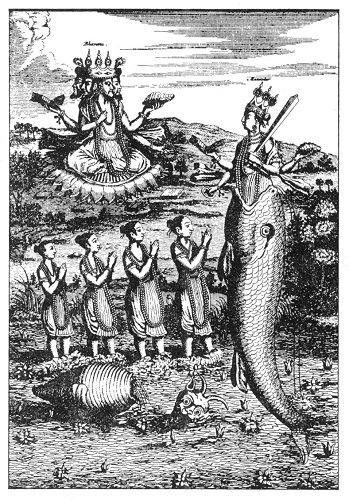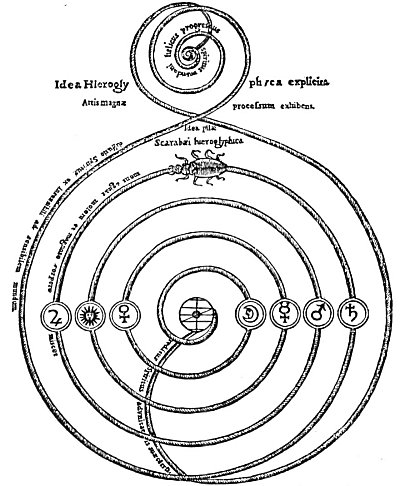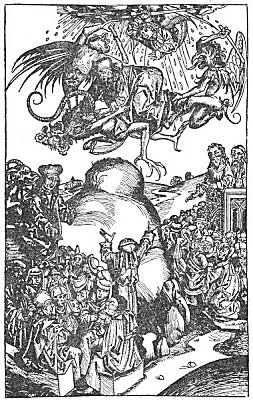The most important of all symbolic animals was the Apis, or Egyptian bull of Memphis, which was regarded as the sacred vehicle for the transmigration of the soul of the god Osiris. It was declared that the Apis was conceived by a bolt of lightning, and the ceremony attendant upon its selection and consecration was one of the most impressive in Egyptian ritualism. The Apis had to be marked in a certain manner. Herodotus states that the bull must be black with a square white spot on his forehead, the form of an eagle (probably a vulture) on his back, a beetle upon (under) his tongue, and the hair of his tail lying two ways. Other writers declare that the sacred bull was marked with twenty-nine sacred symbols, his body was spotted, and upon his right side was a white mark in the form of a crescent. After its sanctification the Apis was kept in a stable adjacent to the temple and led in processionals through the streets of the city upon certain solemn occasions. It was a popular belief among the Egyptians that any child upon whom the bull breathed would become illustrious. After reaching a certain age (twenty-five years) the Apis was taken either to the river Nile or to a sacred fountain (authorities differ on this point) and drowned, amidst the lamentations of the populace. The mourning and wailing for his death continued until the new Apis was found, when it was declared that Osiris had reincarnated, whereupon rejoicing took the place of grief.
The worship of the bull was not confined to Egypt, but was prevalent in many nations of the ancient world. In India, Nandi–the sacred white bull of Siva–is still the object of much veneration; and both the Persians and the Jews accepted the bull as an important religious symbol. The Assyrians, Phœnicians, Chaldeans, and even the Greeks reverenced this animal, and Jupiter turned himself into a white bull to abduct Europa. The bull was a powerful phallic emblem signifying the paternal creative power of the Demiurgus. At his death he was frequently mummified and buried with the pomp and dignity of a god in a specially prepared sarcophagus. Excavations in the Serapeum at Memphis have uncovered the tombs of more than sixty of these sacred animals.
As the sign rising over the horizon at the vernal equinox constitutes the starry body for the annual incarnation of the sun, the bull not only was the celestial symbol of the Solar Man but, because the vernal equinox took place in the constellation of Taurus, was called the breaker or opener of the year. For this reason in astronomical symbolism the bull is often shown breaking the annular egg with his horns. The Apis further signifies that the God-Mind is incarnated in the body of a beast and therefore that the physical beast form is the sacred vehicle of divinity. Man’s lower personality is the Apis in which Osiris incarnates. The result of the combination is the creation of Sor-Apis (Serapis)-the material soul as ruler of the irrational material body and involved therein. After a certain period (which is determined by the square of five, or twenty-five years), the body of the Apis is destroyed and the soul liberated by the water which drowns the material life. This was indicative of the washing away of the material nature by the baptismal waters of divine light and truth. The drowning of the Apis is the symbol of death; the resurrection of Osiris in the new bull is the symbol of eternal renovation. The white bull was also symbolically sacred as the appointed emblem of the initiates, signifying the spiritualized material bodies of both man and Nature.
When the vernal equinox no longer occurred in the sign of Taurus, the Sun God incarnated in the constellation of Aries and the ram then became the vehicle of the solar power. Thus the sun rising in the sign of the Celestial Lamb triumphs over the symbolic serpent of darkness. The lamb is a familiar emblem of purity because of its gentleness and the whiteness of its wool. In many of the pagan Mysteries it signified the Universal Savior, and in Christianity it is the favorite symbol of Christ. Early church paintings show a lamb standing upon a little hill, and from its feet pour four streams of living water signifying the four Gospels. The blood of the lamb is the solar life pouring into the world through the sign of Aries.

Moe is the founder of GnosticWarrior.com. He is a father, husband, author, martial arts black belt, and an expert in Gnosticism, the occult, and esotericism.








![How the Isle of Wight received Christian inhabitants, and two royal youths of that island were killed immediately after Baptism [686 A. D.] | Book 4 | Chapter 16 How the Isle of Wight received Christian inhabitants, and two royal youths of that island were killed immediately after Baptism [686 A. D.] | Book 4 | Chapter 16](https://www.gnosticwarrior.com/wp-content/plugins/contextual-related-posts/default.png)